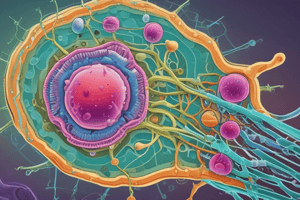Podcast
Questions and Answers
What is the result of chemical reactions that break down large molecules?
What is the result of chemical reactions that break down large molecules?
- Reduction of energy
- Formation of complex molecules
- Production of simpler molecules (correct)
- Destruction of small molecules
What is the outcome of the breakdown of large molecules into smaller ones?
What is the outcome of the breakdown of large molecules into smaller ones?
- Increase in complexity
- Absorption of energy
- Release of energy (correct)
- Formation of large molecules
What is the term used to describe the breakdown of large molecules into smaller ones?
What is the term used to describe the breakdown of large molecules into smaller ones?
- Synthesis
- Decomposition (correct)
- Transformation
- Combination
What is the result of the breakdown of large molecules into smaller ones in terms of energy?
What is the result of the breakdown of large molecules into smaller ones in terms of energy?
What is the purpose of chemical reactions that break down large molecules?
What is the purpose of chemical reactions that break down large molecules?
What is the direction of the process of breaking down large molecules into smaller ones?
What is the direction of the process of breaking down large molecules into smaller ones?
What is the characteristic of the molecules produced as a result of the breakdown of large molecules?
What is the characteristic of the molecules produced as a result of the breakdown of large molecules?
What is the term used to describe the energy produced as a result of the breakdown of large molecules?
What is the term used to describe the energy produced as a result of the breakdown of large molecules?
What is the result of the breakdown of large molecules into smaller ones in terms of molecular structure?
What is the result of the breakdown of large molecules into smaller ones in terms of molecular structure?
What is the primary function of chemical reactions that break down large molecules?
What is the primary function of chemical reactions that break down large molecules?
Flashcards are hidden until you start studying
Study Notes
Gram-Negative Bacteria
- Spheroplasts are formed when Gram-negative bacteria are treated similarly, retaining much of their outer membrane structure.
- The distinctive feature of Gram-negative bacteria is lipopolysaccharides (LPS), also known as endotoxin, which is composed of different molecular types.
Structure and Function
- LPS is present in all Gram-negative species, with varying numbers depending on the species.
- Flagella are long, flexible structures used for motility.
- Pili (or fimbriae) are short, rigid, hair-like structures scattered on the bacterial surface, used for attachment.
Composition
- Pili consist of 97-98% water and 2-3% dissolved solids.
Endospores
- Endospores are highly heat-resistant, dehydrated resting cells formed intracellularly, mainly in Bacillus and Clostridium genera.
- Endospores are resistant to chemical reactions that lead to decomposition and breakdown of large molecules into smaller, simpler ones, resulting in energy production.
Studying That Suits You
Use AI to generate personalized quizzes and flashcards to suit your learning preferences.


